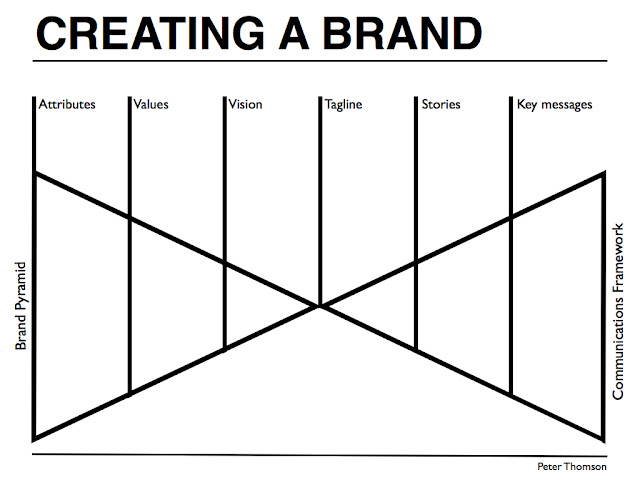Brand strategy is the foundation of all good marketing, advertising and PR. A good brand will help you win customers, raise capital and attract co-founders. You need a minimum viable level of clarity to move fast and adapt your brand as your startup evolves.
Recently I’ve been helping more startups and entrepreneurs with their initial brand creation. What I’ve found is that the challenges that you face starting your own brand are surprisingly similar to the work that I do rebranding multinational companies. A few years back, I put together a new framework for creating a brand strategy. It’s called the Brand Bowtie because it puts together an internal brand architecture pyramid with an external communications pyramid.

The elements of a successful brand are a vision, values, attributes, tagline, stories and key messages. The internal brand architecture is your little secret, but it will inform everything that you do. The external communications framework is an external tool that you can pick and mix from to build websites, social media and marketing collateral.
Step 1: Brand Architecture
The vision for your brand needs to be framed in terms of the difference that you make in your customer’s lives. Aim for a short punchy statement about why you exist. This is not your tagline so don’t wordsmith it too much. Aim for genuine and authentic. Two slightly contrasting words are often a nice way to summarise the vision. Example: BMW’s essence is “driving excellence.”
The values of your brand are also framed in terms of the things that your tribe believes in. This means you, your future employees, distributors, customers and suppliers. Ask yourself what values you wouldn’t go without. But only include ones that are different from your competitors; integrity, innovation and teamwork are just feel-good values. Example: Waitrose cares about ”calm, refined ambience.”
The attributes of your brand are more practical than the values and focus on things that will make your product better than your competitors. Look for attributes that work as a promise to your customers. Example: Uniqlo products promise you “understated value.”
The brand pyramid of vision, values and attributes is your secret. It would be a bit weird to walk up to someone at a party and say “My life purpose is to spread joy in the world.” Likewise, your brand doesn’t just lead with your vision. Instead your brand architecture will provide the base for a communications framework.

Step 2: Communications Framework
Your tagline is where the brand vision comes to life. Your tagline should convey what you do in simple enough terms that someone can instantly know whether you sell what they’re looking for. It needs to address the hidden “So What?” that every customer asks. Example: Nike’s tagline is “Just do it.”
Story telling is one of the most fundamental methods of human communication. The headlines of your brand stories will reflect your values. They will be mini-anecdotes that articulate your values in a way that resonates with your audience. For example, Icebreaker’s “no stink” reputation is built on the stories of travellers wearing their garments for weeks on end.
The key messages are the most prosaic part of your communications framework. Key messages convey your brand attributes in language that meets consumers where they are now and gently leads them to where you want them to be. For example, Apple’s iWork key messages include descriptions of documents you can create. These key messages are much less sexy than the meaning-of-life iPhone marketing but they convey a much more practical benefit to a cynical audience.
DIY branding
The best way to build a brand architecture is to work with a management consultant that understands mission, vision and values. If you’re a cash strapped entrepreneur then you could roll our own brand strategy team by asking a few friends for help:
- Find a life-coach that can help you get clear on what the impact is that you want to have in the world.
- Then take that personal mission and take it to a copywriter in an advertising agency or an internet marketer that specialises in creating products.
- Find a friend that works in marketing or design and share your vision with them and ask “How could I convey this to an audience that are entirely cynical about what I’m trying to do?”
If you really want to take a run at the whole brand strategy all by yourself then I’ve gone ahead and listed below the actual questions that I ask clients in live-fire branding workshops.

Be warned that like a recipe from a chef, the questions are an empty tool without the delicate care needed to use them. But in the interests of letting you behind the curtain, I’ve listed them anyway. Go crazy…
DIY questions to develop a Brand Architecture:
Vision
- What is the impact you want to have in the world?
- How would you like to be remembered?
Values
- What are the things that you wouldn’t give up?
- What would an employee have to believe in for you to think they were a good fit?
Attributes
- What pain do you solve for customers?
- How are your products different to your competitors?
DIY questions to develop a Communications Framework:
Tagline
- What would you put on the side of a truck to tell people that you sell what they need?
- What words would someone google if they were looking for your type of products?
Stories
- What are the anecdotes that people tell about you?
- Are there any unexpected challenges that you’ve overcome?
Key messages
- How do you make your offering safe for people to say yes to?
- If you had to describe your products to your mum then what would you say?
Work your way through these questions imagining that you’re at a small pub in rural Ireland telling a yarn to the locals over a beer. Focus on conveying the spirit of the message in a way that resonates with the listener.
Your brand strategy is a living thing so it won’t be perfect the first time but it will give you something to build on. It only needs to be good enough to let you make faster and better decisions to move the business forwards.

Peter this is an excellent write up. The brand architecture as a framework and questions you guided me through really helped me get clear on my value and my message. The tagline, stories and key messages are super important to communicate in such a way to be understood, relevant and to attract the audience I want to connect with as a starting point in the conversation leading to impact and change. Thank you so much for your help in this journey, I’m enjoying the evolution of my brand. Caveman Klaus
This framework has been incredibly powerful and useful in drilling down to what we want our company to stand for — and communicating it powerfully. Thank you.
I would love to see a completed example of this